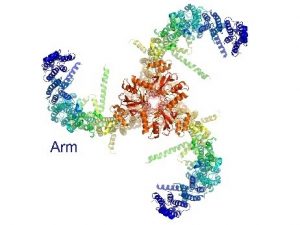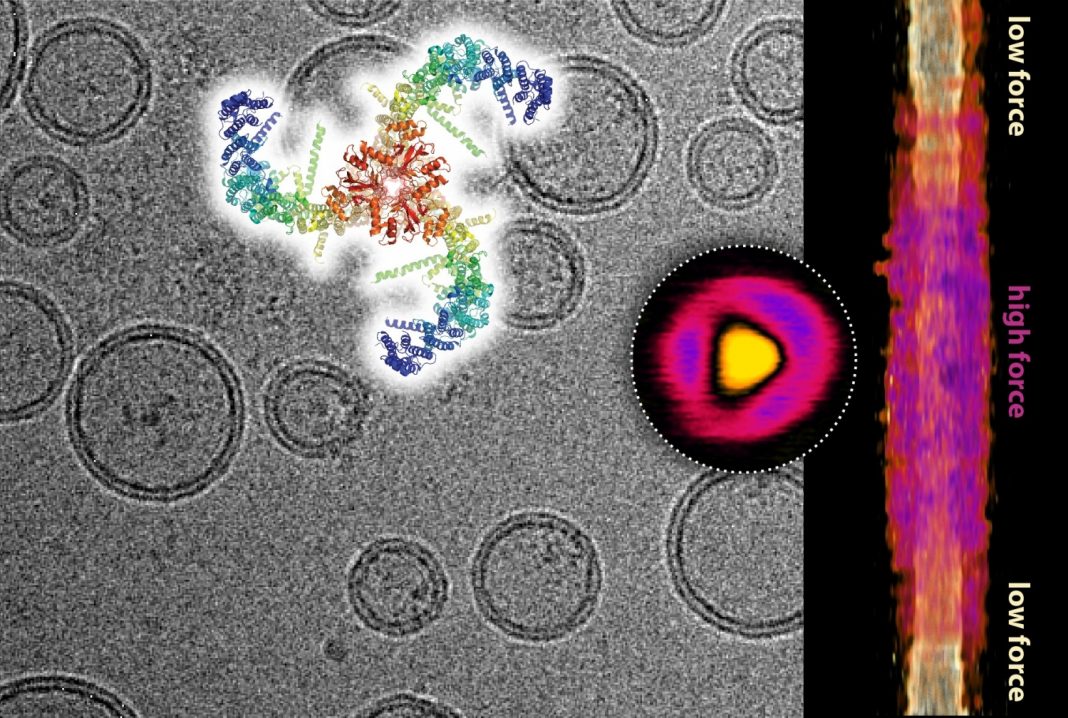Researchers from Weill Cornell Medicine and the Rockefeller University say they have uncovered the basic mechanism of Piezo proteins, which function as sensors in the body for mechanical stimuli such as touch, bladder fullness, and blood pressure. The discovery opens up many new paths of investigation into the roles of Piezo proteins in human diseases and potential new therapeutic strategies, according to the scientists.
In the study (“Force-induced conformational changes in PIEZO1”), published in Nature, the team used advanced microscopy techniques to image the Piezo1 protein at rest and during the application of mechanical forces. They confirmed this complex protein’s structure and showed essentially how it can convert mechanical stimuli into an electrical signal.
“Piezo1 is a mechanosensitive channel that converts applied force into electrical signals. Partial molecular structures show that Piezo1 is a bowl-shaped trimer with extended arms. Here we use cryo-electron microscopy to show that Piezo1 adopts different degrees of curvature in lipid vesicles of different sizes. We also use high-speed atomic force microscopy to analyze the deformability of Piezo1 under force in membranes on a mica surface and show that Piezo1 can be flattened reversibly into the membrane plane,” the investigators wrote.

Professor of physiology and biophysics
Weill Cornell Medicine
“By approximating the absolute force applied, we estimate a range of values for the mechanical spring constant of Piezo1 . Both methods of microscopy demonstrate that Piezo1 can deform its shape towards a planar structure. This deformation could explain how lateral membrane tension can be converted into a conformation-dependent change in free energy to gate the Piezo1 channel in response to mechanical perturbations.”
“Our analysis shows that tension on the cell membrane in which Piezo1 is embedded can flatten and widen the protein’s structure,” said co-senior author Simon Scheuring, PhD, a professor of physiology and biophysics in anesthesiology at Weill Cornell Medicine. Scheuring and his laboratory collaborated on the study with the laboratory of Roderick MacKinnon, PhD, a professor of molecular neurobiology and biophysics at the Rockefeller University. MacKinnon was co-recipient of the Nobel Prize in Chemistry in 2003 for his work determining the structures and mechanisms of ion channel proteins.
Piezo1 and Piezo2 are large and complex proteins with unique structures. They are embedded within the membranes of certain cell types, and their function is to transduce mechanical force on cells into electrical signals that alter cell activity.

Advances in imaging techniques have enabled scientists in recent years to determine the basic structure of Piezo1, a structure that Piezo2 is thought to mostly share. From above this structure has a three-armed, propeller, or triskelion appearance.
From the side it looks like a shallow bowl embedded in the cell membrane, with an ion channel at its center. The latter, when opened, allows a flow of calcium and other positively charged ions into the cell.
The basic mechanism by which mechanical force opens the ion channel has remained mysterious. But in the new study, Scheuring, MacKinnon, and their colleagues, including lead author Yi-Chih Lin, PhD, a postdoctoral associate in anesthesiology, were able to get a clearer picture of how it works.
They combined cryo-electron microscopy with a less well-known technique called high-speed atomic force microscopy, which produces an image of an object essentially by feeling its surface with a super-sensitive mechanical probe. They showed with these methods that Piezo1 is a springy structure that normally bends the cell membrane where it sits, but will flatten out when, for example, a mechanical force is applied to the cell membrane.
“As the membrane tension increases, the structure of Piezo1 flattens and stretches out to occupy a larger area, which in turn opens the ion channel,” Scheuring said.
He noted the possibility that other stimuli that stretch and flatten the Piezo1 structure, such as a pulling force on its arms from the inside or on an external domain called the CED from the outside the cell, in principle could open the ion channel, making it a suitably versatile mechanism for the wide range of cell types and physiological functions in which it works.
Moreover, given this wide range of cell types, in organs including the lungs, bladder, intestines, and pancreas, as well as in blood vessels and the sensory nervous system, the discovery of the basic Piezo-protein mechanism could lead to new ways of understanding and treating many human diseases.
To take one example, Scheuring said, if the membranes of cells lining blood vessels contain excess cholesterol, they would become stiffer, increasing the background tension on embedded Piezo1 proteins and potentially disrupting these proteins’ normal ability to detect and help regulate blood pressure.
“Our finding leads to a great many predictions about Piezo proteins’ roles in disease that we and others can now go and investigate,” he noted.



